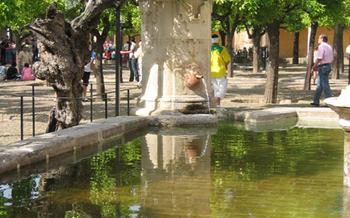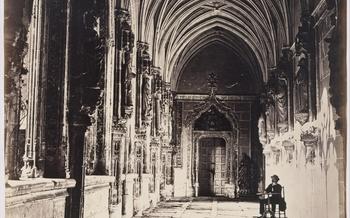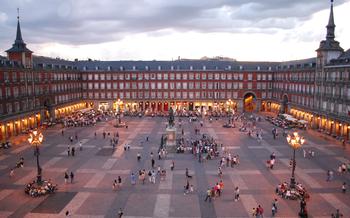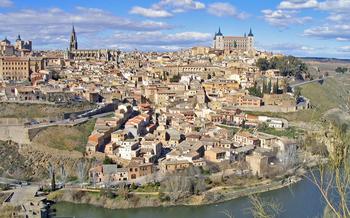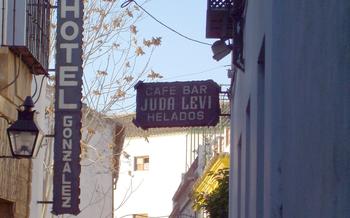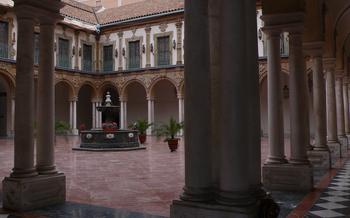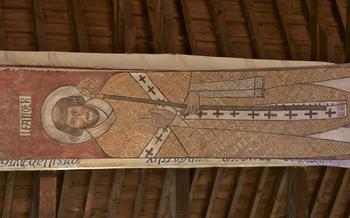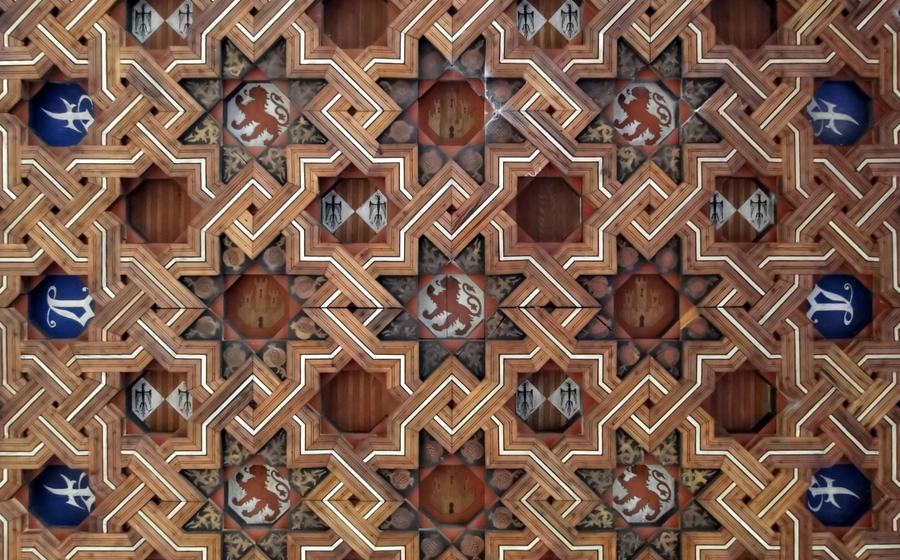
Monastery of San Juan de los Reyes
- The Monastery of San Juan de los Reyes, a Gothic Jewel in Toledo
- The Claustro de los Reyes: A Peaceful Oasis in the Heart of the Monastery
- The Church of the Monastery: A Showcase of Gothic Architecture
- The Royal Tombs: A Tribute to the Catholic Monarchs
- The Capilla de los Reyes Nuevos (Chapel of the New Kings) floor plan with a ribbed vault ceiling and large stained glass windows that illuminate the interior with colorful light.
- The Museo del Ejército (Army Museum): A Journey Through Military History
- The Library of the Monastery: A Treasure Trove of Knowledge
- The Sacristy of the Monastery: A Repository of Sacred Objects
- The Tower of the Monastery: A Stunning Viewpoint Over Toledo
- The Gardens of the Monastery: A Tranquil Retreat
- The Surroundings of the Monastery: Exploring the Jewish Quarter
- The Legend of the Two Beheaded Knights
- The Monastery of San Juan de los Reyes in Literature and Art
- Practical Information for Visitors
- Insider Tip: The Best Time to Visit
The Monastery of San Juan de los Reyes, a Gothic Jewel in Toledo
The Monastery of San Juan de los Reyes stands as a testament to the grandeur of Gothic architecture and the deep-rooted Catholic faith that shaped Spain's history. Founded in 1477 by the Catholic Monarchs, Isabella I of Castile and Ferdinand II of Aragon, this magnificent edifice holds within its walls a wealth of artistic and historical treasures.
History of the Monastery
The construction of the monastery began in 1477 under the patronage of the Catholic Monarchs to commemorate their victory over the Portuguese at the Battle of Toro in 1476 and to serve as a royal mausoleum. The chosen site was a former Jewish synagogue, reflecting the city's complex religious history and the growing power of the Catholic Church during the Reconquista.
Architectural Highlights
The architectural style of the monastery is a blend of late Gothic and Mudéjar elements, showcasing the fusion of Christian and Islamic influences that characterized Spanish art at the time. Its intricate stone carvings, delicate tracery, and soaring arches create a harmonious and awe-inspiring spectacle.
The Importance of the Catholic Monarchs
The Catholic Monarchs played a pivotal role in the history of the monastery. Their patronage and support ensured its construction and contributed to its artistic and cultural significance. Their decision to establish the monastery in Toledo, the former capital of the Visigothic kingdom, underlined their commitment to consolidating the Christian monarchy and uniting the kingdoms of Castile and Aragon.
Current Use of the Monastery
Today, the Monastery of San Juan de los Reyes serves as a living testament to Spain's rich history and religious heritage. It continues to function as a monastery, home to a community of Franciscan friars who maintain the spiritual traditions of the order. Additionally, the monastery is open to the public as a museum, allowing visitors to explore its architectural wonders, artistic treasures, and historical significance.
The Claustro de los Reyes: A Peaceful Oasis in the Heart of the Monastery
The Claustro de los Reyes (Cloister of the Kings) is a serene courtyard located at the heart of the Monastery of San Juan de los Reyes. Constructed in the Gothic style, this tranquil space exudes an aura of tranquility and invites visitors to immerse themselves in its harmonious ambiance.
The courtyard's architectural features are characterized by graceful arches supported by slender columns, creating a sense of lightness and elegance. The walls are adorned with intricate carvings depicting biblical scenes, historical events, and symbolic motifs, adding to the cloister's visual richness.
At the center of the courtyard lies a beautifully manicured garden, providing a splash of color and life to the serene space. The garden is meticulously landscaped with a variety of flowers, shrubs, and trees, creating a delightful oasis within the monastery's walls.
The Claustro de los Reyes serves as a reminder of the harmonious integration of nature and architecture that was prevalent during the Gothic period. It is a place of contemplation and reflection, inviting visitors to find solace and tranquility amidst the grandeur of the monastery.
The Church of the Monastery: A Showcase of Gothic Architecture
The church of the Monastery of San Juan de los Reyes is a stunning example of Gothic architecture, with its soaring vaults, intricate ribbed arches, and delicate tracery windows. The exterior of the church is adorned with elaborate carvings and sculptures, depicting biblical scenes and the coats of arms of the Catholic Monarchs. The interior of the church is equally impressive, with its grand nave, side chapels, and the magnificent royal chapel.
The grand façade of the church is a masterpiece of Gothic architecture, with its three pointed portals, intricate carvings, and a large rose window. The impressive interior is divided into three naves by slender columns, which support the ribbed vaults that soar overhead. The royal chapel, located in the apse, is the most elaborate part of the church, with its intricate carvings, stained glass windows, and the elaborate tombs of Isabella and Ferdinand.
The altar of the church is a work of art in itself, with its intricate carvings, gilded details, and a large altarpiece depicting scenes from the life of Christ. The elaborate decoration of the church reflects the wealth and power of the Catholic Monarchs, who spared no expense in creating a magnificent place of worship.
The Royal Tombs: A Tribute to the Catholic Monarchs
In the heart of the Monastery of San Juan de los Reyes, visitors can pay homage to the illustrious monarchs who played a pivotal role in shaping Spain's history. The elaborate tombs of Isabella I of Castile and Ferdinand II of Aragon, known as the Catholic Monarchs, stand as testaments to their enduring legacy.
Crafted from exquisite white marble, the tombs are adorned with intricate carvings and sculptures that depict scenes from the lives of the monarchs, their triumphs, and their devotion to the Catholic faith. The effigies of the monarchs, rendered with remarkable detail, capture their regal bearing and serene expressions.
Isabella and Ferdinand's tombs are not merely works of art but also symbols of their profound impact on Spain's history. They were instrumental in unifying the kingdoms of Castile and Aragon, establishing the foundation for a unified Spanish monarchy. Their reign ushered in an era of exploration, conquest, and cultural flourishing, known as the Golden Age of Spain.
The Catholic Monarchs were also staunch supporters of the Reconquista, the centuries-long struggle to reclaim the Iberian Peninsula from Muslim rule. Their victory in the Siege of Granada in 1492 marked the culmination of the Reconquista and the beginning of a new era for Spain.
The Monastery of San Juan de los Reyes serves as a fitting resting place for these revered monarchs, who left an indelible mark on Spain's history and culture. Their tombs stand as a reminder of their devotion to their faith, their unwavering determination, and their enduring legacy as the architects of a unified and powerful Spanish nation.
The Capilla de los Reyes Nuevos (Chapel of the New Kings) floor plan with a ribbed vault ceiling and large stained glass windows that illuminate the interior with colorful light.
The chapel's most striking feature is its impressive altarpiece, a masterpiece of Renaissance sculpture created by Esteban Jordán and Pedro Machuca. The altarpiece depicts scenes from the life of Christ and the Virgin Mary, surrounded by elaborate ornamentation and sculptures of biblical figures.
The chapel also houses the tombs of Juana la Loca and Felipe el Hermoso, which are located in the center of the room. These tombs are made of white marble and feature intricate carvings and sculptures that depict the monarchs in lifelike detail. The tombs are adorned with symbols of royalty and power, such as crowns, scepters, and orbs.
The Museo del Ejército (Army Museum): A Journey Through Military History
The Monastery of San Juan de los Reyes houses the Museo del Ejército, a fascinating museum dedicated to the history of the Spanish military. The museum boasts an impressive collection of weapons, uniforms, and military artifacts, providing visitors with a comprehensive overview of Spain's military heritage from ancient times to the present day.
The Collection of the Museum The museum's collection includes an array of exhibits, including medieval swords and armor, Renaissance firearms, and modern military equipment. Visitors can admire the elaborately decorated suits of armor worn by knights during the Reconquista and marvel at the intricate craftsmanship of ancient weapons. The museum also features a section dedicated to the Spanish Civil War, displaying uniforms, weapons, and personal belongings of soldiers from both sides of the conflict.
The Focus on the Spanish Army The Museo del Ejército primarily focuses on the history of the Spanish Army, showcasing its role in major conflicts throughout history. Visitors can learn about the army's involvement in the Reconquista, the Napoleonic Wars, and the Spanish-American War. The museum also highlights the army's participation in international peacekeeping missions, demonstrating Spain's commitment to global security.
The Exhibits on the Catholic Monarchs and the Reconquista The museum dedicates a significant section to the Catholic Monarchs, Isabella I of Castile and Ferdinand II of Aragon, who played a crucial role in the Reconquista and the unification of Spain. Visitors can see exhibits on the monarchs' military campaigns, their strategies, and the impact of their reign on the Spanish military.
The Interactive Displays The Museo del Ejército incorporates interactive displays and multimedia presentations to enhance the visitor experience. Visitors can watch videos, listen to audio recordings, and engage with interactive exhibits that provide a deeper understanding of military history and the stories behind the artifacts. These interactive elements make the museum a great destination for visitors of all ages, especially for those interested in military history.
The Library of the Monastery: A Treasure Trove of Knowledge
The Monastery of San Juan de los Reyes houses a remarkable library that stands as a testament to the intellectual and cultural pursuits of the Catholic Monarchs. Within its hallowed halls, visitors can discover a treasure trove of rare books and manuscripts, carefully preserved and cataloged for posterity. The collection boasts a diverse array of religious and theological texts, reflecting the deep piety and devotion that permeated the lives of Isabella and Ferdinand.
Among the library's most prized possessions are manuscripts meticulously penned by hand, adorned with intricate illuminations that showcase the artistry and craftsmanship of the era. These manuscripts delve into a wide range of subjects, including biblical exegesis, patristic writings, and medieval philosophy, offering a glimpse into the intellectual landscape of the time. The collection also encompasses works on history, science, and literature, attesting to the broad interests and intellectual curiosity of the Catholic Monarchs.
The establishment of the library at the Monastery of San Juan de los Reyes underscores the monarchs' profound commitment to scholarship and learning. They recognized the importance of preserving and disseminating knowledge, believing that it was essential for the moral and spiritual well-being of their subjects. The library thus served as a center of intellectual exchange, where scholars and students could access a wealth of knowledge and engage in fruitful discussions and debates.
Furthermore, the library played a pivotal role in the cultural and intellectual development of Toledo. As a center of learning and scholarship, it attracted renowned scholars and intellectuals from across the country, fostering a vibrant intellectual community within the city. The presence of the library enriched the cultural fabric of Toledo, contributing to its reputation as a hub of knowledge and erudition during the reign of the Catholic Monarchs.
Today, the library of the Monastery of San Juan de los Reyes continues to be a valuable resource for scholars and researchers, providing access to a wealth of primary sources that illuminate the history, culture, and religious beliefs of medieval Spain. Its collection stands as a testament to the enduring legacy of the Catholic Monarchs, whose patronage and foresight ensured the preservation of this priceless repository of knowledge for generations to come.
The Sacristy of the Monastery: A Repository of Sacred Objects
The sacristy of the Monastery of San Juan de los Reyes is a treasure trove of sacred objects and vestments that have been collected over the centuries. It is a testament to the monastery's long history and its role as a center of religious devotion. The sacristy is home to a variety of liturgical objects, including chalices, monstrances, and reliquaries, many of which are made of gold and silver and adorned with precious stones. The vestments, which include chasubles, dalmatics, and copes, are made of fine fabrics and are often elaborately embroidered with religious motifs.
The sacristy is also home to a number of historical documents, including the original foundation charter of the monastery and the wills of the Catholic Monarchs. These documents provide valuable insights into the history of the monastery and the lives of its founders. The sacristy is a fascinating place to visit for anyone interested in the history of the Catholic Church or the art and architecture of the Middle Ages.
The development of the sacristy was greatly influenced by the patronage of the Catholic Monarchs, who donated many of the objects that are housed there. The sacristy is not only a repository of sacred objects but also a testament to the piety and generosity of the Catholic Monarchs, who were deeply devoted to the Catholic faith.
The artistic value of the objects in the sacristy is undeniable. Many of the pieces are exquisite works of craftsmanship, and they reflect the high level of artistic achievement that was attained in Spain during the Middle Ages. The sacristy is a valuable resource for scholars of art history, as it provides a glimpse into the development of Spanish religious art.
The Tower of the Monastery: A Stunning Viewpoint Over Toledo
Standing tall and proud, the tower of the Monastery of San Juan de los Reyes is an iconic landmark in Toledo. Its construction began in the 15th century, commissioned by the Catholic Monarchs, and was completed in the 16th century. The tower, designed in the late Gothic style, exhibits intricate architectural details, including decorative pinnacles, gargoyles, and traceried windows.
Ascend the winding staircase to the top of the tower and be rewarded with breathtaking panoramic views of Toledo. From this elevated vantage point, visitors can gaze upon the city's historic landmarks, including the Alcázar of Toledo, the Cathedral of Toledo, and the Tagus River winding its way through the landscape.
The tower's strategic position within the monastery complex symbolizes the power and influence of the Catholic Monarchs. It served as a watchtower, allowing the monks to keep a vigilant eye over the surrounding area. The tower also functioned as a bell tower, its majestic bells tolling to mark important religious events and occasions.
Today, the tower of the Monastery of San Juan de los Reyes stands as a testament to the architectural prowess and historical significance of the monastery. It is a must-visit attraction for anyone seeking to experience the beauty and grandeur of Toledo's rich heritage.
The Gardens of the Monastery: A Tranquil Retreat
Amidst the Gothic grandeur of San Juan de los Reyes, visitors can find solace and tranquility in the monastery's serene gardens. Designed with meticulous care, the gardens offer a harmonious blend of nature and architecture, inviting visitors to immerse themselves in a world of beauty and peace.
The gardens are laid out in a symmetrical fashion, with neatly trimmed hedges, colorful flower beds, and carefully placed trees. The air is filled with the fragrant aroma of roses, lavender, and jasmine, creating a sensory experience that delights the senses.
Water features play an integral role in the gardens' design, adding a soothing element to the tranquil atmosphere. Fountains and ponds are strategically placed throughout the gardens, creating a gentle murmur that enhances the sense of serenity.
The gardens of San Juan de los Reyes are not just a place of beauty but also a place for contemplation and relaxation. Visitors can stroll along the gravel paths, find a secluded spot to sit and reflect, or simply bask in the warm Spanish sun. The gardens provide a welcome respite from the hustle and bustle of city life, offering a sanctuary for peace and tranquility.
Whether you are seeking a moment of solitude, inspiration, or simply a chance to appreciate the beauty of nature, the gardens of San Juan de los Reyes are a must-visit for any visitor to Toledo.
The Surroundings of the Monastery: Exploring the Jewish Quarter
The Monastery of San Juan de los Reyes is situated in the heart of Toledo's historic Jewish Quarter, a vibrant and fascinating neighborhood that offers visitors a glimpse into the city's rich multicultural past. The Jewish Quarter, also known as the Judería, was once home to a thriving Jewish community that played a significant role in Toledo's economic, cultural, and intellectual development during the Middle Ages.
The streets of the Judería are a maze of narrow cobblestone alleys, lined with historic synagogues, churches, and other buildings that tell the story of the city's diverse past. Visitors can explore the beautifully preserved Synagogue of Santa María la Blanca, one of the oldest and most well-preserved synagogues in Europe, as well as the Synagogue of El Tránsito, which now houses the Sephardic Museum.
The Jewish Quarter is also home to several churches that were built on the sites of former synagogues after the expulsion of the Jews from Spain in 149These churches, such as the Church of Santo Tomé, contain stunning works of art, including the famous painting "The Burial of the Count of Orgaz" by El Greco.
Today, the Jewish Quarter is a vibrant and multicultural neighborhood, with a mix of traditional and modern shops, restaurants, and bars. Visitors can enjoy the lively atmosphere, sample the delicious local cuisine, and soak up the rich history of this unique part of Toledo.
The Legend of the Two Beheaded Knights
An intriguing legend is associated with the Monastery of San Juan de los Reyes, captivating visitors with its tale of injustice and miraculous intervention. According to this legend, two noble knights, Don Pedro de Avellaneda and Don Juan de Luna, were unjustly accused of treason and sentenced to death by King Henry IV of Castile. Despite their pleas of innocence, they were beheaded on the very spot where the monastery now stands.
As the knights lay lifeless on the ground, a miraculous event occurred. Their severed heads miraculously lifted off the ground and stood upright, facing each other in a silent act of defiance. The witnesses to this astonishing sight were awestruck, and the king was filled with remorse for his hasty judgment.
The legend of the two beheaded knights has become an integral part of the monastery's history, symbolizing the triumph of justice over adversity. The figures of the two knights, with their heads held high, have been incorporated into the monastery's coat of arms, serving as a reminder of the legend and the importance of justice and fair judgment.
The Monastery of San Juan de los Reyes in Literature and Art
The Monastery of San Juan de los Reyes has been a source of inspiration for artists, writers, and musicians throughout history. Its unique blend of architectural styles, its rich history, and its association with the Catholic Monarchs have made it a popular subject for literary, artistic, and musical works.
In literature, the monastery has been featured in novels, poems, and plays. The Spanish playwright Lope de Vega wrote a play about the monastery entitled "La corona merecida" (The Crown Deserved), which tells the story of the founding of the monastery and the lives of the Catholic Monarchs. The monastery has also been the setting for several novels, including "El caballero de Olmedo" (The Knight of Olmedo) by Lope de Vega and "El capitán Alatriste" (Captain Alatriste) by Arturo Pérez-Reverte.
In art, the monastery has been depicted in paintings, sculptures, and engravings. The most famous painting of the monastery is "The Burial of Count Orgaz" by El Greco, which depicts the burial of a nobleman in the church of the monastery. The monastery has also been the subject of several sculptures, including a statue of Isabella and Ferdinand by the sculptor Juan de Juni.
In music, the monastery has been featured in several compositions, including a symphony by the Spanish composer Joaquín Turina entitled "Sinfonía del Monasterio de San Juan de los Reyes" (Symphony of the Monastery of San Juan de los Reyes). The monastery has also been the setting for several operas, including "La corona merecida" by Lope de Vega and "El capitán Alatriste" by Arturo Pérez-Reverte.
The Monastery of San Juan de los Reyes is a symbol of Spain's rich history and culture. Its unique blend of architectural styles, its association with the Catholic Monarchs, and its place in literature, art, and music make it a must-see for anyone interested in Spanish history and culture.
Practical Information for Visitors
The Monastery of San Juan de los Reyes welcomes visitors all year round. Opening hours are from 10:00 AM to 6:30 PM, with the last admission at 6:00 PM. Admission fees are reasonable, with discounts available for students, seniors, and families. Guided tours in Spanish and English are offered at specific times throughout the day, providing an in-depth exploration of the monastery's history and architecture. Audio guides are also available in multiple languages for those who prefer to explore at their own pace. The monastery is wheelchair accessible, with ramps and elevators facilitating movement throughout the complex. To fully appreciate the monastery's serene atmosphere and avoid crowds, consider visiting during the off-season or on weekdays.
Insider Tip: The Best Time to Visit
To fully appreciate the beauty and tranquility of the Monastery of San Juan de los Reyes, it's crucial to choose the right time for your visit. The best time of day to visit is early in the morning or late in the afternoon, when the sunlight casts a warm glow on the intricate carvings and the crowds are smaller.
In terms of the time of year, spring and fall offer the most pleasant weather for exploring Toledo. During these seasons, you'll be greeted by blooming flowers, comfortable temperatures, and fewer tourists. Summer in Toledo can be quite hot and crowded, while winter can be chilly and wet.
If you're interested in attending special events or festivals, be sure to plan your visit accordingly. The monastery often hosts concerts, exhibitions, and religious ceremonies throughout the year.
To avoid the crowds and enjoy a more tranquil experience, consider visiting the monastery on a weekday rather than a weekend. You'll have more space to wander around and soak in the atmosphere without feeling rushed.
No matter when you choose to visit, the Monastery of San Juan de los Reyes is a must-see destination for anyone interested in history, architecture, or spirituality. Its unique blend of Gothic grandeur and royal legacy will leave a lasting impression on all who visit.

